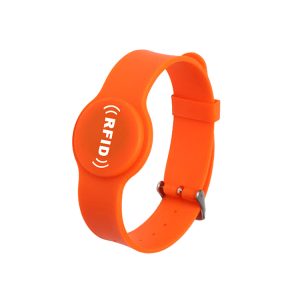Pag-ila sa Frequency sa Radyo (Rfid) Ang teknolohiya nakaagi sa mahinungdanong pag-uswag sa bag-ohay nga mga tuig, pagbag-o sa paagi sa pagdumala sa mga negosyo sa imbentaryo, track asset, ug pagpalambo sa seguridad. Samtang ang panginahanglan alang sa real-time nga visibility ug data-driven insights nagpadayon sa pagtubo, ubay-ubay nga nag-uswag nga mga uso ang nag-umol sa kaugmaon sa teknolohiya sa RFID.
1. Internet sa mga Butang (IOT) Paghiusa: Ang panagsama sa RFID sa Internet sa mga Butang (IOT) nagbag-o sa koneksyon ug interoperability sa lainlaing mga aplikasyon. Pinaagi sa paghiusa sa mga tag sa RFID ug mga magbabasa sa mga platform sa IoT, ang mga organisasyon makamugna og intelihente nga ekosistema nga makapahimo sa hapsay nga komunikasyon tali sa pisikal nga mga butang ug digital nga mga sistema. Kini nga convergence nagpadali sa gipaayo nga pagkolekta sa datos, pagtuki, ug paghimog desisyon, pag-abli sa bag-ong mga oportunidad alang sa automation, pagkaepisyente, ug kabag-ohan.
2. Hybrid RFID Systems: Hybrid RFID systems, nga naghiusa sa passive ug aktibo nga mga teknolohiya sa RFID, nakakuha og traksyon alang sa mga aplikasyon nga nanginahanglan parehas nga long-range visibility ug barato nga scalability. Pinaagi sa paggamit sa passive RFID tags para sa lebel sa item tracking ug aktibong RFID tags para sa real-time nga pagmonitor sa mga asset o personnel, makab-ot sa mga organisasyon ang komprehensibo nga visibility sa ilang mga operasyon. Kini nga hybrid nga pamaagi nagtanyag sa pagka-flexible sa pagpahiangay sa lain-laing mga kaso sa paggamit samtang gipadako ang mga benepisyo sa parehong passive ug aktibo nga RFID nga mga teknolohiya.
3. Gipauswag nga Seguridad sa Data: Uban sa pagdagsang sa RFID-enabled nga mga himan ug sa pagdugang sa gidaghanon sa data nga gipadala wirelessly, pagsiguro nga ang seguridad sa datos nahimong labing hinungdanon. Mga advanced nga algorithm sa pag-encrypt, luwas nga mga protocol, ug tamper-resistant RFID tags kay gihimo aron mamenosan ang mga hulga sa cybersecurity ug mapanalipdan ang sensitibong impormasyon. Dugang, ang paghiusa sa teknolohiya sa blockchain sa mga sistema sa RFID adunay saad alang sa pagpauswag sa integridad sa datos, pagkasubay, ug transparency, ilabina sa mga industriya sama sa pagdumala sa kadena sa suplay ug pag-atiman sa panglawas.
4. Edge Computing ug Real-Time Analytics: Ang pagsagop sa mga teknolohiya sa edge computing nakapahimo sa mga sistema sa RFID sa pagproseso sa datos nga mas duol sa punto sa pagkuha., pagkunhod sa latency ug bandwidth nga mga kinahanglanon. Pinaagi sa pag-deploy sa mga edge computing platform kauban ang RFID readers, ang mga organisasyon makahimo sa pag-analisar sa datos sa tinuod nga panahon, panghiling sa panghitabo, ug paghimog desisyon sa edge sa network. Kini makapauswag sa pagtubag, scalability, and reliability, ilabina sa dinamikong mga palibot diin ang dali nga mga panabut hinungdanon.
5. Miniaturization ug Flexible Form Factors: Ang mga pag-uswag sa mga teknolohiya sa miniaturization nagduso sa pag-uswag sa mas gagmay, mas flexible RFID tags uban sa gipalambo nga performance ug durability. Kini nga mga miniaturized nga mga tag mahimong i-embed sa daghang mga materyales, lakip ang mga tela, mga plastik, ug bisan mga likido, pagbukas sa bag-ong mga posibilidad alang sa RFID-enabled nga mga aplikasyon sa mga industriya sama sa fashion, pag-atiman sa panglawas, ug pagputos sa pagkaon. Pa pa, Ang flexible form factor makahimo sa mga tag sa RFID nga makasugakod sa mapintas nga mga palibot ug lain-laing mga kondisyon sa pag-operate, pagsiguro sa kasaligan nga pasundayag sa mahagiton nga mga kahimtang.
6. Malungtaron nga mga Solusyon sa RFID: Ingon nga ang pagpadayon nahimo nga hinungdanon nga prayoridad sa mga negosyo sa tibuuk kalibutan, adunay usa ka nagtubo nga focus sa pagpalambo sa eco-friendly RFID solusyon. Naglakip kini sa paggamit sa mga materyales nga ma-recycle, mga disenyo nga episyente sa enerhiya, ug mga estratehiya sa pagdumala sa lifecycle aron mamenosan ang epekto sa kinaiyahan. Dugang, RFID-enabled sustainability initiatives, sama sa smart waste management ug green supply chain optimization, nagtabang sa mga organisasyon sa pagpakunhod sa basura, pagkonserbar sa mga kahinguhaan, ug pagkab-ot sa ilang mga tumong sa pagpadayon.
7. AI-Driven Insights ug Automation: Ang panagsama sa artificial intelligence (Ai) uban sa RFID nga teknolohiya naghatag gahum sa mga organisasyon sa pagkuha sa mga aksyon nga panan-aw gikan sa RFID data ug pag-automate sa mga proseso sa paghimog desisyon. Ang mga algorithm sa AI mahimong mag-analisar sa daghang gidaghanon sa datos sa RFID aron mahibal-an ang mga sumbanan, pagtagna sa mga uso, ug pag-optimize sa mga operasyon sa tinuud nga oras. Kini makahimo sa proactive maintenance, predictive nga pagdumala sa imbentaryo, ug personal nga kasinatian sa kustomer, pagmaneho sa kahusayan ug kompetisyon sa lainlaing mga industriya.
Sa konklusyon, ang kaugmaon sa teknolohiya sa RFID gihulagway pinaagi sa kabag-ohan, panagtapok, ug sustainability. Pinaagi sa pagsagop sa mga nag-uswag nga uso sama sa IoT integration, hybrid nga sistema, gipalambo nga seguridad, edge computing, miniaturization, pagpadayon, ug AI-driven insights, Ang mga organisasyon mahimong magamit ang tibuuk nga potensyal sa teknolohiya sa RFID aron makab-ot ang digital nga pagbag-o, operational excellence, ug malungtarong pagtubo sa nagkadugtong nga kalibutan.
![Taghimo sa Rfid Tag [Wholesale | Om | Odm]](https://www.fjrfidfactory.com/wp-content/uploads/2024/04/logo.webp)






